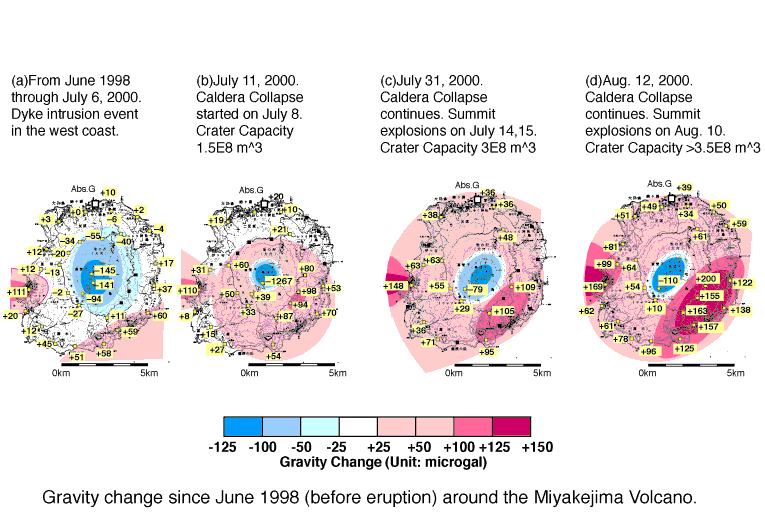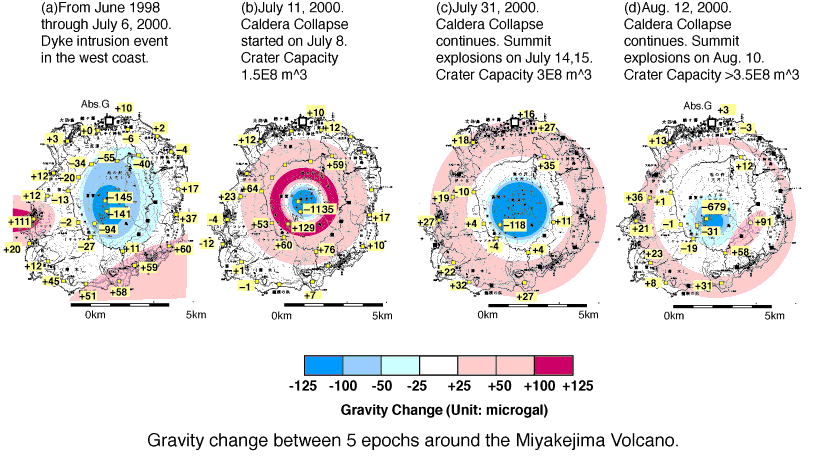"Spatio-temporal Gravity Variation During the 2000
Volcanic Activity of the Miyakejima Volcano"
(presented by the ERI Gravity Group: Shuhei Okubo
(okubo@eri.u-tokyo.ac.jp), Masato Furuya, Sun Wenke, Yoshiyuki
Tanaka, Hidefumi Watanabe, Jun Oikawa, Tokumitsu Maekawa)
The figures below show gravity change at four epochs with
reference to the gravity in June 1998. Steadily
increasing gravityin the west coast suggests a channel through
which magma is flowing out from the volcano to the swarm zone off the
west coast of the island. Gravity
increase in the south-southeastern part draws our attention.
Gravity decrease in the central part is
mostly due to the collapse of the summit caldera. The decrease in
Figs. (c) and (d) appears to be less spectacular than that in Fig.
(b). But this is more apparent than real because we could not observe
gravity data any longer at points lost forever by the caldera
collapse. If they were still available, we would have observed much
more prominent gravity decrease.

"From a
Supernova to a Vacuum Cleaner: Interpretation"
�$B!&�(J Magma is sucked in by the collapse at the summit of
Miyakejima volcano, and it spreads the wave of gravity change in all
directions. It is just like to see a birth of a
SUPERNOVA, which is discharging gas with an imploding core at
the last stage of star's life.
�$B!&�(JWhy is magma sucked out? The key to the answer is held
in the generation of innumerable cracks in the swarm region
stretching from the Miyakejima Island toward the Kozushima and
Niijima Islands. At the end of the crack, solid-fluid (magma of
hydrothermal?) interaction drives a positive feedback; expansion of
cracks induces fluid flowing in and more fluid at the crack tips
promotes further growth of cracks. Vast space of continuously
generated cracks should remain vacuum. Magma may be passively sucked
out toward that space (vacuum cleaner
model).The model is based on the following grounds.
- Steady gravity increase on the southwest coast suggests
continuous charging of fluid (Fig. d).
- Steady shrinking* of the Miyakejima Island observed with GPS
indicates steady flow-out of magma.
- If sucked out magma is presumed to flow back to just beneath
the Miyakejima Island, we meet difficulty in explaining the
gravity value at Abs.G installed in the north of the island.
- Order estimate about the volume: effective dimension of cracks
is presumed to be 50km long and10km wide with 2m tensile opening.
That makes the volume to 10 E8 m^3 , and it can easily contain 4
E8 m^3of collapse volume of the summit of Miyakejima volcano.
The figures below show differentials in between the five epochs.

Explanation
- (a) From the beginning of the activity to just before the
collapse (July 6, 2000)
- Gravity decrease at the summit (approx.
- 140) was due to the creation of cavity (depth 1.5km,
capacity > 6E8 m^3) responsible for ever growing summit crater.
- Gravity increase in southwest of
the island (+111) was due to
intrusion of dyke (tensile opening 1.7 meter).
- Gravity increase (approx.+60)
along the coast was due to the subsidence of the whole
island caused by deflation of the deep magma chamber.
- (b) From just before the collapse (July 6) to just after
the collapse (July 11-14).
The collapse of summit had continued to develop: capacity was 5 E7
m^3 on July and 1.5E8 m^3 on July 11.
- Gravity decrease at the summit
(- 1135 microgals�$B!*�(J) was due
to the mass deficiency associated with the large-scale growing
collapse of the caldera.
- Gravity increase from approx.
50 to 130 microgals along the inner
circular path. In this area the crater is above the eye level. The
loss of pulling-up Newton attraction leads to the gravity
increase.
Cocentric gravity change suggest cylindrical conduits beneath the
summit. If collapse and drain-back/flow out of magma will continue,
gravity at the center of the island (high elevation) will decrease
and it will increase around the coast (low elevation).
- (c) From July 11-14 through July 28-31
Steam explosions occurred on July 14, and 15. The summit
crater became deeper (450m) with a capacity of 3 E8 m^3.
- At the site with +129 microgals
in Fig. (b), gravity decrease of -118
microgals is observed. This is because the center of
gravity of the summit crater descended below the eye level of
seismic station due to the growing collapse (depression).
- The center of collapse is above the eye level at the loop
coastal road, and so gravity increases.
Gravity change is spreading as the cocentric circles.
- (d) From July 28-31 through August 10 -12
Steam explosions occurred on August 10, 14, and 15. The
crater became deeper (500m) and a capacity increased.(the value
unknown)
- Around the summit gravity decreased as much as 680 microgals. This is because the crater
rim was approaching to the observation stations.
- Gravity increase of 58 to 91
microgals in the east area indicates the caldera is
extending to the east.
- As the center of collapse is descending, white region (neutral
change) is also descending (approaching to the coastal area).
- The center of mass of the crater is above the eye level along
the coast, so gravity increases there.


